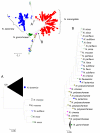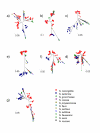Fuzzy species among recombinogenic bacteria
- PMID: 15752428
- PMCID: PMC554772
- DOI: 10.1186/1741-7007-3-6
Fuzzy species among recombinogenic bacteria
Abstract
Background: It is a matter of ongoing debate whether a universal species concept is possible for bacteria. Indeed, it is not clear whether closely related isolates of bacteria typically form discrete genotypic clusters that can be assigned as species. The most challenging test of whether species can be clearly delineated is provided by analysis of large populations of closely-related, highly recombinogenic, bacteria that colonise the same body site. We have used concatenated sequences of seven house-keeping loci from 770 strains of 11 named Neisseria species, and phylogenetic trees, to investigate whether genotypic clusters can be resolved among these recombinogenic bacteria and, if so, the extent to which they correspond to named species.
Results: Alleles at individual loci were widely distributed among the named species but this distorting effect of recombination was largely buffered by using concatenated sequences, which resolved clusters corresponding to the three species most numerous in the sample, N. meningitidis, N. lactamica and N. gonorrhoeae. A few isolates arose from the branch that separated N. meningitidis from N. lactamica leading us to describe these species as 'fuzzy'.
Conclusion: A multilocus approach using large samples of closely related isolates delineates species even in the highly recombinogenic human Neisseria where individual loci are inadequate for the task. This approach should be applied by taxonomists to large samples of other groups of closely-related bacteria, and especially to those where species delineation has historically been difficult, to determine whether genotypic clusters can be delineated, and to guide the definition of species.
Figures


Similar articles
-
Species status of Neisseria gonorrhoeae: evolutionary and epidemiological inferences from multilocus sequence typing.BMC Biol. 2007 Sep 7;5:35. doi: 10.1186/1741-7007-5-35. BMC Biol. 2007. PMID: 17825091 Free PMC article.
-
Ecological separation and genetic isolation of Neisseria gonorrhoeae and Neisseria meningitidis.Curr Biol. 1993 Sep 1;3(9):567-72. doi: 10.1016/0960-9822(93)90001-5. Curr Biol. 1993. PMID: 15335669
-
Population structure in the Neisseria, and the biological significance of fuzzy species.J R Soc Interface. 2012 Jun 7;9(71):1208-15. doi: 10.1098/rsif.2011.0601. Epub 2011 Nov 9. J R Soc Interface. 2012. PMID: 22072450 Free PMC article.
-
Sequences, sequence clusters and bacterial species.Philos Trans R Soc Lond B Biol Sci. 2006 Nov 29;361(1475):1917-27. doi: 10.1098/rstb.2006.1917. Philos Trans R Soc Lond B Biol Sci. 2006. PMID: 17062411 Free PMC article. Review.
-
Comparison of the genome organization of pathogenic neisseriae.Electrophoresis. 1998 Apr;19(4):577-81. doi: 10.1002/elps.1150190419. Electrophoresis. 1998. PMID: 9588805 Review.
Cited by
-
What Is Speciation?PLoS Genet. 2016 Mar 31;12(3):e1005860. doi: 10.1371/journal.pgen.1005860. eCollection 2016 Mar. PLoS Genet. 2016. PMID: 27030977 Free PMC article. Review.
-
Fuzzy species revisited.BMC Biol. 2013 Apr 15;11:41. doi: 10.1186/1741-7007-11-41. BMC Biol. 2013. PMID: 23587266 Free PMC article. Review. No abstract available.
-
Novel molecular method for identification of Streptococcus pneumoniae applicable to clinical microbiology and 16S rRNA sequence-based microbiome studies.J Clin Microbiol. 2012 Jun;50(6):1968-73. doi: 10.1128/JCM.00365-12. Epub 2012 Mar 21. J Clin Microbiol. 2012. PMID: 22442329 Free PMC article.
-
Genome dynamics of short oligonucleotides: the example of bacterial DNA uptake enhancing sequences.PLoS One. 2007 Aug 15;2(8):e741. doi: 10.1371/journal.pone.0000741. PLoS One. 2007. PMID: 17710141 Free PMC article.
-
Chromosome architecture constrains horizontal gene transfer in bacteria.PLoS Genet. 2018 May 29;14(5):e1007421. doi: 10.1371/journal.pgen.1007421. eCollection 2018 May. PLoS Genet. 2018. PMID: 29813058 Free PMC article.
References
-
- Stackebrandt E, Frederiksen W, Garrity GM, Grimont PA, Kampfer P, Maiden MC, Nesme X, Rossello-Mora R, Swings J, Truper HG, et al. Report of the ad hoc committee for the re-evaluation of the species definition in bacteriology. Int J Syst Evol Microbiol. 2002;52:1043–1047. doi: 10.1099/ijs.0.02360-0. - DOI - PubMed
Publication types
MeSH terms
LinkOut - more resources
Full Text Sources
Other Literature Sources

